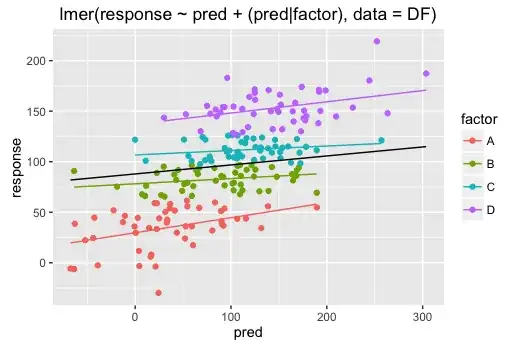What are the difference between a linear mixed model with random slope and intercept and a linear model with an interaction effect?
If I predict the effect of 1) the main effect and 2) the random effect / the interaction, I get different results and am wondering about the reasons.
Take the following example:
# simulate data
set.seed(999)
response <- rnorm(200, 100, 50)
set.seed(777)
dev <- rnorm(response, 0, 50)
DF <- data.frame(response = response) %>%
mutate(pred = response + dev) %>%
arrange(response) %>%
mutate(factor = rep(LETTERS[1:4], each = 50))
# classical linear model
mod.lm <- lm(response ~ pred * factor, data = DF)
PRED <- predict(mod.lm, type = "terms")
Const <- attr(PRED,"constant")
# predict
PRED.df <- data.frame(y = PRED) %>%
mutate(y.pred = y.pred + Const) %>%
mutate(y.factor = y.factor + Const) %>%
mutate(y.pred.factor = y.pred + y.factor + y.pred.factor - Const) %>%
mutate(x = as.vector(DF$pred)) %>%
mutate(factor = as.vector(DF$factor))
#plot
ggplot(DF,aes(x = pred, y = response, colour = factor))+
geom_point()+
geom_line(data = PRED.df, aes(x = x, y = y.pred), colour = "black")+
geom_line(data = PRED.df, aes(x = x, y = y.pred.factor))+
labs( title = "lm(response ~ pred * factor, data = DF)")
# linear mixed model with lme4
mod.lme4 <- lmer(response ~ pred + (pred|factor), data = DF)
# predict
PRED.lme4 <-
data.frame(y = predict(mod.lme4, re.form = NA)) %>%
mutate(y2 = predict(mod.lme4, re.form = ~ (pred|factor))) %>%
mutate(x = as.vector(DF$pred)) %>%
mutate(factor = as.vector(DF$factor))
# plot
ggplot(DF,aes(x = pred, y = response, colour = factor))+
geom_point()+
geom_line(data = PRED.lme4, aes(x = x, y = y), colour = "black")+
geom_line(data = PRED.lme4, aes(x = x, y = y2))+
labs( title = "lmer(response ~ pred + (pred|factor), data = DF)")
gives
and
I agree that the differences are not huge but still appreciable (and will also depend on the data)

